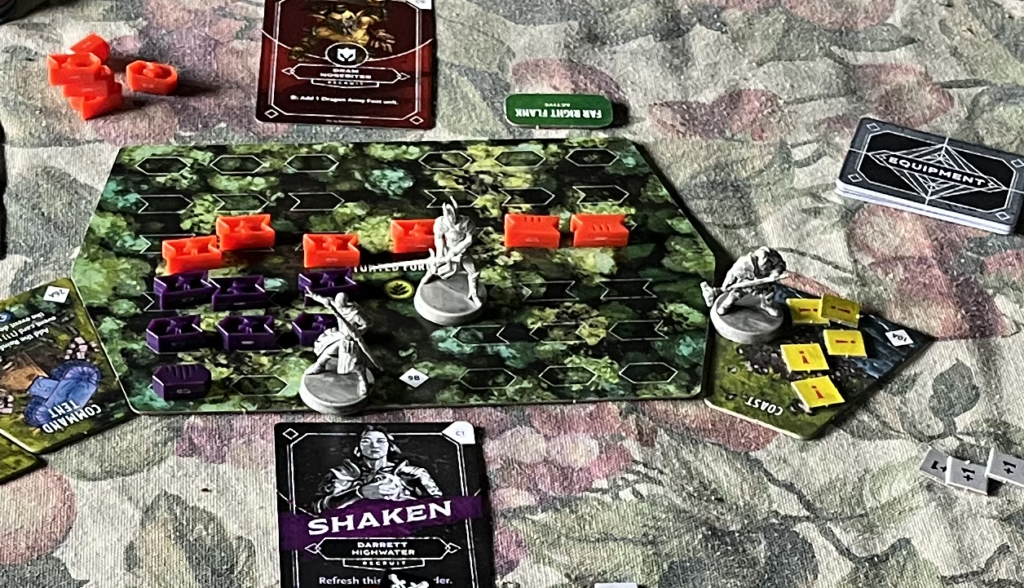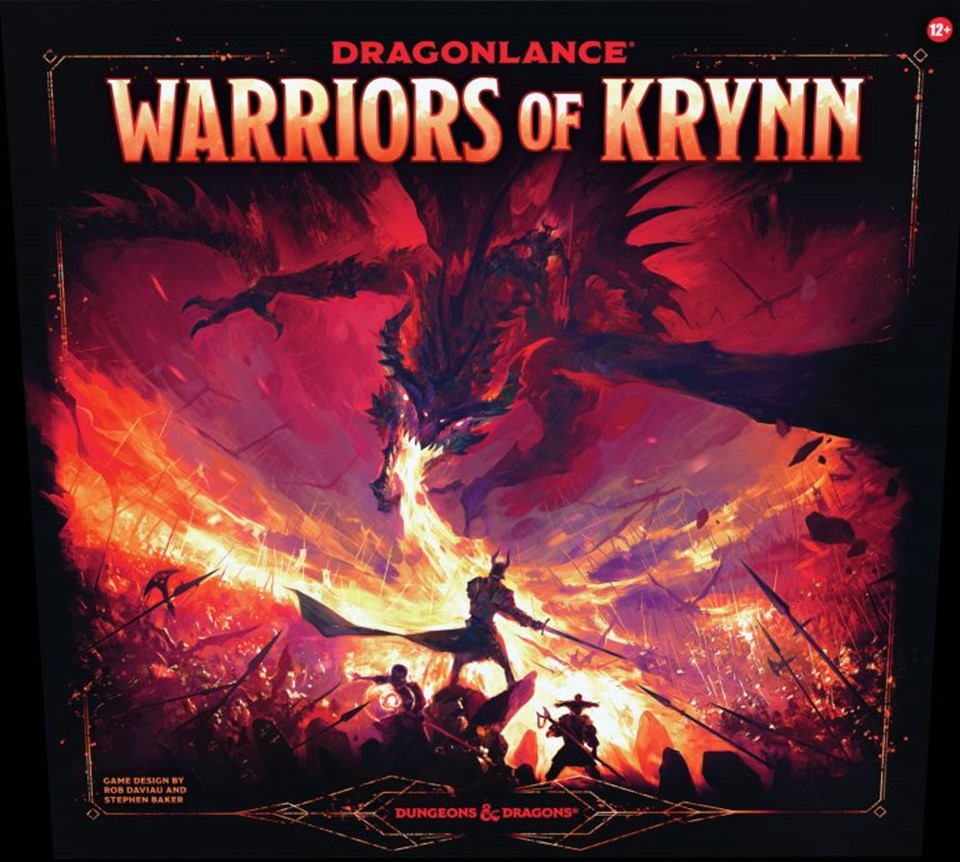Warriors of Krynn is not the game I was expecting.
When I heard that the new Dragonlance adventure, Shadow of the Dragon Queen, was getting a supplementary board game for resolving the clashes between armies, I though that it would be about, you know, battles between armies.
It isn’t.
Well, it is, but that’s in the background. Instead, it’s about the actions of the heroes during those battles.
Warriors of Krynn is a co-operative game for three to five players in which you attempt to succeed at tasks before the Dragon-armies of Takhisis defeat your forces. It is possible for a scenario to end in a military victory for you. Towards the end of the campaign, this becomes more likely and some of the victory conditions require this. More often, you need to fulfil the objectives before you’re overwhelmed.
In this, it feels a bit like War of the Ring, where the Fellowship player can win militarily, but more often they’ll win by destroying the One Ring before they’re overwhelmed by the forces of Sauron. However, this game is nothing like War of the Ring.
The game includes twelve campaign scenarios, plus one training scenario. You can play the twelve scenarios as a campaign where your success in one has a minor effect on the next. Each player starts by choosing a character. Their abilities are determined by the matching class card – the classes are the core classes of Dungeons & Dragons, like fighter, cleric, and wizard. In this way, you can play “your” character from the Shadow of the Dragon Queen adventure.
I have now played two scenarios – the training scenario and the first of the campaign. I’m not going to get into the mechanics much, but each player takes a turn in order, and on their turn, they first draw an event card, then perform four actions, then possible gain a respite if they’re on an empty tile, then finally resolve a round of mass combat action.
Those four actions? A lot of them are going to be taken up by moving. My experiences have been a lot of running around the battlefield. Roads can reduce the number of actions required, but there’s likely still a lot of actions used moving.
Many actions require you to roll special dice to resolve. You get one die by default and can spend some of your allotted actions or discard ability cards to get more dice. Once all of this is considered, you’ll often only do one significant action on your turn. Sometimes that action can help you do well on the battlefield, most times you’ll want to go after the scenario objectives.
As with most co-operative games, there’s a feeling of trying to race the game’s clock. Can we fulfil our objectives before the Dragonarmies win? Thematically, it’s on point. I think it’s refreshing that you can defeat the Dragonarmies in some scenarios, even if that isn’t the standard.
Although the game is for three to five players, there is no hidden information I could see. As such, I was able to play the game solitaire, controlling three characters – as each character has their own distinct turn, this was easy to accomplish.
Is it a fun game? Yes, it is.
Will it suit your group? Now, that’s trickier to say.
This game isn’t a mass-combat simulator. You won’t be able to take it and use it to simulate any battle in D&D. The scenario design changes things up, but because its co-operative, balance is a major issue. This game would have been playtested again and again, to make the difficulty of winning acceptable. It abstracts a lot of things. It’s very clever, but you can’t use it outside of what it’s designed for without a significant effort.
And that difficulty of winning? It presumes a certain skill level. There’s no dial to adjust the difficulty, as in a co-operative game like Pandemic. If your group is very skilled at this sort of game, you can probably win everything. If you’re not, then you’ll get very frustrated. (Heck, due to random events, you may just get frustrated anyway).
The game has some really clever mechanics in it. I love how events work. There’s one “Key Event” card in the deck which triggers a scenario-specific event, and provides another timer for the game. When it’s revealed, you reshuffle all the discards (including it), and place them on the bottom of the rest of the deck. This means that you won’t get three Key Events in a row, though if it’s the last card in the deck, you might get two in a row. It provides for randomness but mitigates it. Good design!
The armies are represented by tokens for numbers of troops, with an army having 0 to 6 of each of Infantry, Missile, and Cavalry. At the end of the turn, one of the flanks resolves a battle, either a skirmish which only involves one type of troop, or a full assault with all troops involved. For each troop type, whoever has the most troops of that type is the attacker and draws a resolution card. The cards are different for the faction and troop type, so six decks in total. Cards can inflict hits, get you to roll dice to see how many hits you get, or have other effects. On a tie for troop numbers, the game wins. Tactic tokens placed by the players can give their force a temporary advantage.
Units hit once become “shaken”, the second hit destroys them. And yes, some heroes and leaders can rally shaken troops.
While the mass combat system works, and mostly works well, it has some oddities. If hits are inflicted on a troop type that has no more troops, then those hits are ignored. This means that a full Dragon Army can spend several turns failing to kill the lone infantry unit opposing it. This is weird.
A few other notes:
Component-wise: The cardboard looks pretty but is relatively thin. It’s not as bad as some board game products Wizards has produced, but it doesn’t feel as durable as it should. This is especially true of the many cards in the game; I advise sleeving if you play this often. You get six miniatures for your heroes which are okay. The plastic tokens for the armies are just fine. There’s nothing special about them – but they are functional, if occasionally difficult to distinguish between.
Player count: There is a significant disconnect between how many players the D&D adventure book is for (five to seven, including DM), and how many players the board game supports (three to five). For a lot of groups, one or more players will have to sit out, which is not good. The DM can choose to roll Dragonarmy dice and read cards, but if they do so, they get no decision-making role in the game. This isn’t that attractive to me, but you may be okay with this.
Fun value: I enjoyed it, despite (in general) not liking co-operative board games. But co-operative games can cause a lot of issues, so I’d be wary of that. Most board games have a puzzle element, but that tends to be the point in this sort of game. It won’t fit everyone.
Game length: I’m not sure. I’m presuming that scenarios will typically take from one to two hours, but this may be extended due to player discussions. Obviously, as I was playing solitaire, those discussions weren’t occurring! There is set-up time, which I’d estimate at being 10-15 minutes. This is of particular import when you’re trying to integrate this with the RPG adventure.
What it looks like: Please admire my tablecloth. Or ignore it. This is from the end of the first campaign scenario.

The quality of the photo isn’t great, but if you zoom in, you can see there are purple (friendly) tokens on the forest tile. Here – let’s zoom in for you!

Those cards on either side are the battlefield commanders, whom I haven’t talked about. The yellow tokens are objective markers – in this case, villagers who I was trying to save. I save five – so that’s a “Hold” result, otherwise known as a draw.
Although there are only two battlefield tiles in this map, later scenarios have more – up to five.
Yes, my initial impressions are that it’s a fun game. But as a supplement to the RPG scenario? I’m a bit more mixed on that. I hope to add more later.


The Key Event reshuffle is of course a variant on the dynamic created by the Epidemic cards in Pandemic. Not meant as a criticism, and the variant is meaningfully different, but just observing about game design. Likewise, four actions, of which some are often movement, is very similar in design to Pandemic–although it looks like this has less of the Graph Theory: The Boardgame dynamic than Pandemic sometimes does.
Does it feel like Dragonlance at all? I’ve followed the RPG hardcover loosely and I understand that they’ve distanced themselves from the original characters. Is there anything about this that actually feels like a Dragonlance game or could it easily be a generic fantasy game?